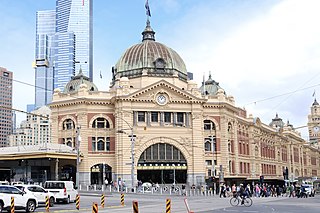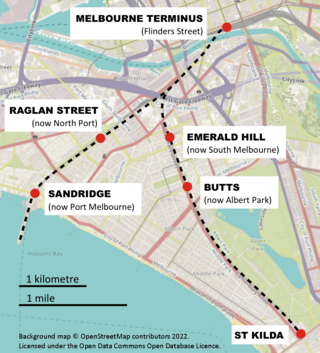List of railway stations in Melbourne may refer to:
List of railway stations in Melbourne may refer to:

Flinders Street railway station is a train station located on the corner of Flinders and Swanston streets in Melbourne, Victoria, Australia. It is the second busiest train station in Australia, serving the entire metropolitan rail network, 15 tram routes travelling to and from the city, as well as some country and regional V/Line services to eastern Victoria. Opened in 1854, the station is the oldest in Australia, backing onto the Yarra River in the central business district, the complex includes 13 platforms and structures that stretch over more than two city blocks, from east of Swanston Street to nearly at Market Street.

North Melbourne is an inner-city suburb in Melbourne, Victoria, Australia, 3 km (1.9 mi) north-west of Melbourne's Central Business District, located within the City of Melbourne local government area. North Melbourne recorded a population of 14,953 at the 2021 census.

Noble Park is a suburb in Melbourne, Victoria, Australia, 25 km south-east of Melbourne's Central Business District, located within the City of Greater Dandenong local government area. Noble Park recorded a population of 32,257 at the 2021 census.

Elsternwick is an inner suburb in Melbourne, Victoria, Australia, 9 km south-east of Melbourne's Central Business District, located within the City of Glen Eira local government area. Elsternwick recorded a population of 10,887 at the 2021 census.

Hawksburn railway station is a commuter railway station on the Frankston line, serving the south Melbourne suburb of South Yarra, Victoria, Australia. Hawksburn is an unstaffed status below ground structure station featuring four platforms, with an island platform and two side platforms all accessed by a pedestrian bridge. The station is listed on the Victorian Heritage Register, and was opened on 7 May 1879, with the stations’ namesake being the locality of Hawksburn, 600 metres from the station. The station is only partially accessible due to multiple steep access ramps.

Armadale railway station is a commuter railway station in Armadale, a suburb of Melbourne, Victoria, Australia. The station is listed on the Victorian Heritage Register and was opened on 7 May 1879. The station consists of an island platform and two side platforms, all accessed by a pedestrian bridge. There are two principal station buildings located on the central platform and on platform 4, consisting of a small two and one-story brick buildings. These buildings were provided in 1914 as ticketing and staff offices. The station is only partially accessible due to a multiple steep access ramps.

Caulfield railway station is a commuter railway station on the northern boundary of Caulfield East, a suburb of Melbourne, Victoria, Australia. Opened in 1879 and rebuilt from 1913 to 1914, the station complex is listed on the Victorian Heritage Register and is noted as an example of Federation Free Style architecture. It is named after the nearby suburb of Caulfield, located southwest of the station.

North Melbourne railway station is the junction for the Craigieburn, Flemington Racecourse, Sunbury, Upfield, Werribee and Williamstown lines in Victoria, Australia. It serves the inner-northern Melbourne suburb of West Melbourne, and opened on 6 October 1859.

The Sandringham line is a commuter railway line in the city of Melbourne, Victoria, Australia. Operated by Metro Trains Melbourne, it is the city's fourth shortest metropolitan railway line at 17.9 kilometres (11.1 mi). The line runs from Flinders Street station in central Melbourne to Sandringham station in the south-east, serving 14 stations via South Yarra, Balaclava, Elsternwick, and Brighton. The line operates from approximately 5am to 12am, daily, with 24 hour service available on Friday and Saturday nights. Services run every 7–8 minutes during peak hour, with services running every 15 minutes during the inter-peak period on weekdays, and every 20 minutes at night and during the day on weekends. Additionally, services run every 60 minutes overnight on Friday and Saturday nights as part of the Night Network.

The Melbourne rail network is a metropolitan suburban and freight rail system serving the city of Melbourne, Victoria, Australia. The metropolitan rail network is centred around the Melbourne central business district (CBD) and consists of 222 railway stations across 16 lines, which served a patronage of 99.5 million over the year 2021–2022. It is the core of the larger Victorian railway network, with regional links to both intrastate and interstate rail systems.

Spring Street is a major street in the Melbourne central business district, Australia. It runs roughly north-south and is the easternmost street in the original 1837 Hoddle Grid.

The Melbourne and Hobson's Bay Railway Company was a railway company in Victoria, Australia. The company was incorporated on 20 January 1853 to build the line from Melbourne to the port of Sandridge, now Port Melbourne.

The Geelong and Melbourne Railway Company was a railway company in Victoria, Australia. Alexander Thomson, a member of the Victorian Legislative Council, introduced and mentored a bill to incorporate the Geelong and Melbourne Railway Company. On 8 February 1853, the operation of Melbourne and Geelong Railway Company and Mount Alexander and Murray River Railway Company was approved by the Victoria Government. Thomson was one of the directors and presided at the first shareholder meeting. Work began at the Geelong end in 1854 but progress was slow due to a labour shortage caused by the Victorian gold rush, so the Victorian government hired out 100 prisoners to the company at a daily rate of five shillings each. They were housed in prison hulks moored in Corio Bay. English engineer and surveyor, Edward Snell, undertook the survey and design of the line, including a station and extensive workshops at Geelong, and a number of bluestone and timber bridges.

The Spring Vale Cemetery railway line, in Melbourne, Australia, branched from the now Pakenham Line at Springvale railway station, for a short 1.87 km (1.16 mi) journey to the Spring Vale Cemetery. The terminus was a railway station of the same name.

Albury railway station is a heritage-listed railway station at Railway Place, Albury, New South Wales, Australia, adjacent to the border with Victoria, in Australia. It was designed under the direction of John Whitton and built from 1880 to 1881. It was added to the New South Wales State Heritage Register in 1999.